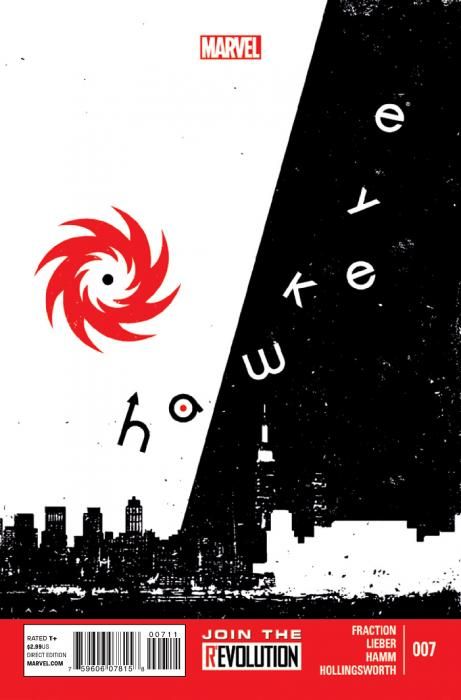In a recent interview with CBR, Fraction said of Clint Barton, "He's the super hero that doesn't matter; all that matters is that he's a super hero" -- one of the most poetic and succinct summations of a character that I've ever read. In "Hawkeye" #7, Matt Fraction, Steve Lieber and Jesse Hamm tell a self-contained, slice-of-life story about what matters, but paradoxically, it's also the least super-heroic of all the "Hawkeye" issues so far. In an issue devoid of capes, masks or intrigue, Clint and Kate face a natural disaster, but the story isn't about Man vs. Nature. Like Clint Barton, it's small-time and big-time at the same time.
"Hawkeye" #7 opens and closes with a view of façade of Clint's apartment building drawn with exactly the same camera angle. If "Hawkeye" #7 was to be dramatically compressed, just those two panels could tell a lot of the story. It's very tidy how there are two Hawkeyes, two locations, and two artists for "Hawkeye" #7, and the artwork is a study in symmetry and contrasts.
"Hawkeye" is a mainstream comic, but as other reviewers have mentioned, it has an indie vibe. A large part of this is due to how artists for are selected for their distinctive, mature style and given enough rein to show the reader what they can do. Lieber's confident, brushy inks knit mesh-like ripples and waves across the surface of water. Hamm draws the same floodwaters with crayon-like squiggles.
Lieber handles Clint's story, and one of the highlights of his style is an appreciation for the power of negative space. In an emotionally climatic panel, the black silhouette of Grills' dad is hunched over while white silhouettes of Clint and Grills hover in a doorway. Lieber also expertly uses the gutters of comics. He plays, extending a background across two panels, or leaving 3/16 of a page blank, and he does these things for function, not for show. His technique is unobtrusive on a quick first read, but upon analysis, all of it enhances emotional effects and narrative pacing.
Hamm is the artist for Kate's story, and his bodies and gestures are more exaggerated than Lieber's, while his line is cleaner. For Kate's moment of joy and triumph, Hamm fills the background with unusually rendered but beautifully simple clouds and trees. These features of Hamm's style suit the lighter, more comic tone of the second half of "Hawkeye" #7. His Kate Bishop is leaner and more girly than David Aja's or Javier Pulido's, but that, too, is in sync with Fraction's script.
Matt Hollingsworth's hues amplify lovely details in Lieber and Hamm's art, including lighting up Ferris wheel on the killer last page of Clint's story. Functionally, Hollingsworth unifies Lieber's and Hamm's artwork under one colorist, but he also divides the issue in two in another way. His palette deliberately reinforces the boundary between inside/outside, warm/cold, and safe/threatening.
As they go inside and outside, into night and morning, neither Hawkeye ever changes into costume (although, Kate does sensibly swap her heels out for hijacked men's oxfords for before sprinting into action), nor do they use the archery gifts that define their identities and codenames as superheroes. "Hawkeye" #7 is a bridge between the private heroism of citizens and neighbors and the loud, public heroism of superheroes.
In Clint's story, Fraction just lets these events and thoughts swirl around, but in Kate's story, Fraction edges a little close to the pitfall of being heavy-handed with the message. He dips into sentimentality before the upbeat and snappy last page. Still, the comic is much more than advertisement or campaign for disaster relief. Not a single arrow is shot in "Hawkeye" #7, but Kate and Clint remain their essential, recognizable selves in "ordinary" adversity, two anchors of a well-structured but delicately gem-like story about people needing each other.

